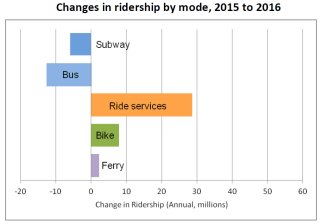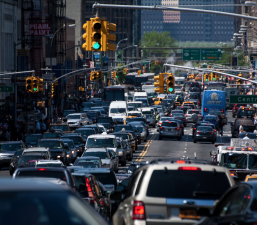Cheaper Gas and Uber Have Manhattan Gridlock Poised to Get Worse
Traffic gridlock in Manhattan has been on the wane for some time. Newly released 2013 traffic counts from the New York Metropolitan Transportation Council show 747,000 motor vehicles entering the Manhattan Central Business District on a typical weekday. While that still constitutes a crushing load, it’s 5,000 fewer cars each day than in 2012 and a drop of 80,000 daily vehicles from the apparent peak year of 2004. As a result, average CBD traffic speeds are on an upswing, from 8 mph in 2006 to 9-9.5 mph in 2012. (Sorry, no figures available for 2004 or 2013.)

A one mile an hour rise is just statistical noise on a fast highway, but summed across hundreds of stop-and-go city blocks over thousands of hours it generates genuine value and significant time savings. Not surprisingly, public aggravation over traffic congestion appears to be less pronounced today than a decade ago. And tellingly, the Move NY toll-reform plan is making headway as much for its promise to fill the funding gap in the MTA capital plan and to bring about “toll equity” by lowering tolls on the MTA bridges, as for its potential to bust gridlock by charging a fee at every CBD entrance and exit.
Nevertheless, I’m betting that Manhattan traffic is about to worsen. The reasons can be spelled out quickly: cheaper gasoline and Uber.
Let’s start with the price of gas, which has already fallen below three bucks a gallon after averaging about $3.60 nationally in 2013 and $3.70 in 2012. Unlike some prior falls that proved transitory, this one looks like it could have staying power owing to the boom in U.S. production, the stutter-stop world economy, and Saudi Arabia’s disinclination to curb production to stabilize prices.
Though conditions vary greatly (especially parking costs), I estimate that a dollar a gallon drop in pump prices would shave 6 percent off the cost of a typical CBD commute. That correlates to an additional 12,000 or so motor vehicle trips to the CBD, on top of the current 640,000 baseline. (My baseline figure differs from NYMTC’s 747,000 because I adjust for through-trips that NYMTC counts as two entries; note also that the rise would be 20,000 but for the “rebound” effect of new trips crowding out some current trips.)
Then there’s Uber. Smartphone-hail services like Uber and Lyft have established a beachhead in the for-hire vehicle industry in New York and other cities. Though solid data isn’t available, these companies appear to be expanding rapidly, and not necessarily at the expense of the traditional yellow-cab and livery sectors or the new green cabs that have expanded the zone of legal street hails. Rather, Uber appears to be creating brand-new demand for travel by motor vehicle, especially within the high-gloss citadel of finance and fashion, the Manhattan CBD.
Currently, yellow cabs provide roughly half-a-million fare trips daily, of which an estimated 85 percent have at least one leg inside the CBD. If smartphone hails bump up the total by just ten percent, that would have the same impact on CBD traffic as 45,000 additional car commutes. Add that to the estimated 12,000 new commutes because of cheaper gas, and the number of vehicle trips to the CBD would rebound to roughly the same level as in 2005 (810,000 CBD entries).
At this point, calculating these effects is mere speculation. And the forces that have shrunk CBD traffic over the past decade — safer and more frequent and reliable transit; unlimited Metrocards; better and more convenient biking; and the generational shift from valorization of cars — are still strong, for the most part (except for the final force, costlier gasoline, which is doing a U-turn).
So my figures here aren’t fact, but a warning: After a decade of slightly less oppressive traffic congestion, Manhattan gridlock could be poised to come roaring back. In which case, some form of pricing on entering the CBD will be even more valuable than it appears right now.

